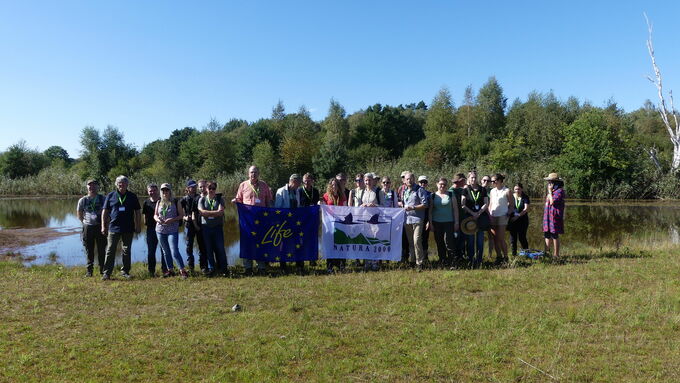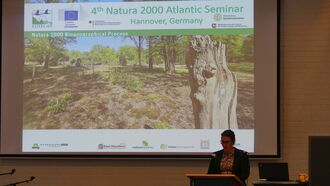The group photo was taken at the second stop ‘Holmer Teiche’. Here, the participants were able to explore some rare plant species. © Bezirksregierung Münster
download picturemain content
Project of the month
#09/2023 NATURA 2000 SEMINAR IN HANNOVER
4th Biogeographical Seminar for the Atlantic Region
From the 4th to the 6th of September, the fourth biogeographical seminar for the Atlantic Region was held in Hanover, Germany, jointly hosted by the European Commission's Directorate-General for the Environment, the Lower Saxony Ministry for the Environment, Energy and Climate Protection and the LIFE IP Atlantic Region DE. As with the previous Atlantic Seminar which had taken place in Antwerp (Belgium) in June 2019, the results of the event will be used to further revise the ‘roadmap’ for the successful implementation of Natura 2000 in the Atlantic region.
Around 100 participants from ten countries met at the ‘Werkhof Hannover’ in plenary sessions and discussed in various breakout sessions as well as parallel working groups. One focus of the first day was the exchange on the so-called pledges that the EU member states are to submit with regard to the targets for protected areas and the improvement of the conservation status of species and habitats for the implementation of the EU Biodiversity Strategy for 2030. In addition, a knowledge market in the evening offered various projects and initiatives the opportunity to present themselves. The LIFE IP Atlantic Region DE also presented itself with two posters.
The second day was dedicated to three parallel running excursion tours to action areas currently managed by the Lower Saxony Water Management, Coastal Defence and Nature Conservation Agency (NLWKN) within the framework of LIFE projects. The first excursion led to the Dümmer, one of 27 project areas of the integrated LIFE project ‘GrassBirdHabitats’ in Lower Saxony. There, around 2,500 hectares of fen have been bought up and rewetted as part of several LIFE projects (1996-2030). This has created one of the most successful meadow bird reserves in Europe bird populations have been increasing strongly ever since. Twelve formerly disappeared breeding bird species have already returned. The primary objective of meadow bird conservation in wet grassland automatically covers other objectives related to biodiversity (e.g. insects), plant species, Natura 2000 habitats and climate.
The destination of the second tour was located north of Hanover near the airport and represents one of the largest and most valuable raised bog complexes in Lower Saxony. The four areas – Otternhagener, Bissendorfer, Helstorfer and Schwarzes Moor – together form the 2,243 hectare action area of the LIFE+ project ‘Hannoversche Moorgeest’. The aim of the project is to restore a near-natural water level and stop rainwater runoff through various construction measures. Since 2021, extensive work such as closure of ditches, removal of woody plants and construction of moor dams has been carried out. During the excursion, an insight into the two largest raised bogs, the Otternhagener and Bissendorfer Moor, was given and the first results as well as current construction activities and technical challenges were presented. Other focal points included preparatory land acquisition, approval procedures and the monitoring of water levels.
The third excursion led to various action areas of the LIFE IP Atlantic Region DE in the Lüneburg Heath. The project and its partners have already implemented numerous measures to improve the focus habitat types and species there. The first destination was the inland dune ‘Großer Sand’ near Sellhorn, where Tom Kutter (project coordinator in Lower Saxony) and employees of the Lower Saxony State Forests from the Sellhorn Forestry Office gave an overview of the large-scale measures implemented to restore a dune area. The large amounts of topsoil that had accumulated had been incorporated into a sand-covered embankment on site. The tour then continued to the ‘Holmer Teiche’ where the problems of Lower Saxony's extensive fish farms and the measures implemented in the area within the framework of the LIFE IP together with the project partner ‘Verein Naturschutzpark Lüneburger Heide’ (VNP) were explained to the participants. During the lunch break, regional providers offered thematically appropriate fish canapés, sausages and pulled meat from the typical moorland sheep ‘Heidschnucke’ in that area at a mobile food van. The tour ended in the ‘Drögener Heide’ near Handeloh where, in cooperation with the VNP and the lower nature conservation authority in the district Heidekreis, three heathland areas with evidence of the smooth snake have been restored along an approximately five-kilometre corridor along an old farm road and a railway line.
The presentations and discussions in the working groups on the last day focused on four topics:
1. protection and conservation of meadow birds.
2. measures for the restoration of peatlands in view of climate change
3. added value of the LIFE integrated projects for nature conservation
4. implementation of the ‘pledges’ on the ground.
In the third workshop, Kristin Gilhaus and Tim Wertebach (both LANUV) presented the goals and actions of the LIFE IP Atlantic Region DE. In particular, the linking of top-down and bottom-up approaches and the communication structures created (for example the so-called ‘Länder-Plattform’) were emphasised. This was followed by an overview by Tom Andries from the Flemish ‘Agentschap voor Natuur en Bos’ on the already completed ‘Belgian Nature Integrated Project’ and the newly launched project ‘Belgium for Biodiversity’ (LIFE B4B). The planned French integrated LIFE project ‘LIFE Biodiv'France’ was also briefly presented before the participants discussed the added values or problems of these large-scale LIFE projects in small groups.
In the closing session, the results of all discussion and working groups were summarised before Frank Vassen from the DG ENV briefly explained the next steps in the pledge process and for the roadmap. Finally, Andrea Vettori, Head of the Nature Conservation Unit of EU DG ENV, closed the event with a strong appeal that climate change forces us all to act and that we now need to quickly start implementation of the EU Biodiversity Strategy in order to successfully complete it by 2030.





